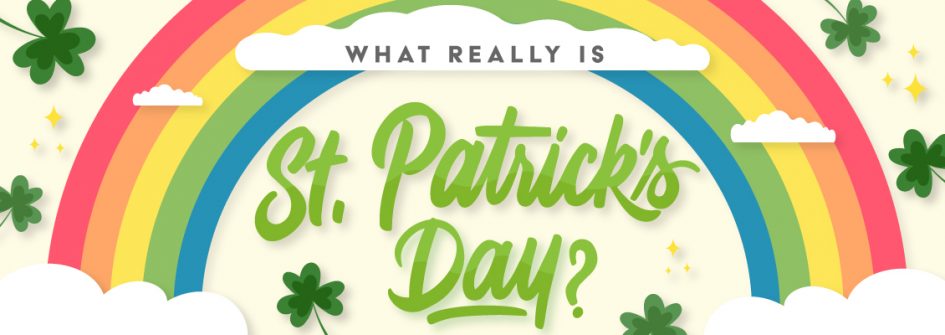Lá Fhéile Naomh Pádraig sona duit, Warhawks! Or in English, “Happy St. Patrick’s Day, Warhawks!” I know that it is still a few days away, but St. Patrick’s Day is one of my favorite holidays to celebrate with my family. Every year we have a feast of traditional Irish food, wear green, and listen to traditional Irish Folk music while playing card games. I know what you might be thinking, “That’s not how I celebrate St. Patrick’s Day” … don’t worry, that is not how a lot of people celebrate Lá Fhéile Pádraig or St. Patrick’s Day here in America. As someone who comes from a family of Irish heritage, my family has stayed true to the St. Patrick’s Day traditions of Ireland as we have learned more and more about what it means to celebrate this holiday. This is in no way a blog about how wrong the American St. Patrick’s Day traditions are, but a chance to read more about what St. Patrick’s Day really is, from an Irish perspective.
The History of St. Patrick’s Day:
St. Patrick’s Day has been reserved as a religious holiday in Ireland for over 1,000 years, and happens every March 17, on the anniversary of St. Patrick’s death. St. Patrick is the patron saint of Ireland, being the first person to introduce Christianity to Ireland during the fifth century. By doing this, St. Patrick was loved by the Irish people, and was the savior of Ireland. Upon his death, the Irish people devoted to always remember and celebrate what he did for their nation, and March 17 become St. Patrick’s Day. Up until the 1970s (when St. Patrick’s Day began to be celebrated more globally) it was a strict religious holiday in Ireland, with pubs, restaurants, and schools being closed on March 17 to reserve this day. Now, it is still seen as a religious holiday in Ireland, but is celebrated with floats, parades, food, gatherings, and parties. Did you know that the three-leaf clover was used by St. Patrick to explain the holy trinity of the Father, Son, and Holy Spirit in Christianity? That is right, and it is worn by Irish natives as a sign of religious devotion and good luck!
Why Wear Green?
We all know that you are supposed to wear green in celebration of St. Patrick’s Day, but do you know why? I didn’t either until reading into some of the traditions behind the celebration of St. Patrick’s Day! Green is tied to the folklore of leprechauns, saying that green is the only color that makes you invisible to them. If you do not wear green, you risked getting pinched!
Why Leprechauns?
Leprechauns are a part of many Irish folklores and were the shoe menders of Irish fairies. However, Irish leprechauns are not the same as American ones, and leprechauns in Irish folklores were cranky, mean, and tricksters! It is said that if you catch a leprechaun, they will grant you three wishes in exchange for being freed. But be careful as they will often try and trick you into asking for a fourth, and if you do, you lose all your wishes and be granted bad luck all year! Since the story has globalized, the traditional ideas of leprechauns have changed, and the idea of them looking for a pot of gold while wearing green has tied itself to St. Patrick’s Day.
St. Patrick’s Day celebrations/traditions in Ireland!
While thinking of things to write about for this blog, I reached out to a friend of mine who lives in Cork County, Ireland and asked her what a St. Patrick’s Day celebration looks like in Ireland. In discussion with her, I was able to learn a lot and found out the following information!
· The day usually starts off with attending mass with your family to pray to the patron St. Patrick.
· Following mass, every town, village, and city hosts a St. Patrick’s Day parade where schools, churches, neighbors, and towns all create large floats to display the Irish flag and fun characters. These parades last a few hours, and everyone participates. If you live in a rural village, tractors are used to tow these floats!
· School children do not have class, and the celebration lasts the whole weekend! The parades always take place on St. Patrick’s Day, so this year, the celebration would last Wednesday-Sunday (sadly, due to the COVID-19 pandemic, there will be no celebrations this year).
· After the parade, families will go to the local pub to feast with their friends and families, where they sing and dance to traditional Irish folk music. Everyone and anyone are welcome to these celebrations, with the idea of family being universal to those around.
· Irish natives will be seen wearing fresh three-leafed clovers pinned to their jackets for good luck and a way of showing their thanks to St. Patrick. It is an unspoken requirement to wear green and to dress up in Irish flag attire, as my friend explained “Ireland is a very proud nation, we are all proud to say we are Irish. You may grow up and out of dressing up for Halloween, but never St. Patrick’s Day!”

Leave a Reply